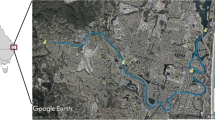Abstract
Model-supported real-time flood control requires the development of effective and efficient hydraulic models. As large numbers of iterations are to be executed in optimization procedures, the hydraulic model needs to be computationally efficient. At the same time, it is also required to generate high-accuracy results. Therefore, an identification and calibration procedure was developed for the purpose of having this conceptual model built up and calibrated based on a limited number of simulations with a more detailed full hydrodynamic model. The performance of the conceptual model was evaluated for historical events under different regulation conditions. Robustness test results show close agreement, with Nash-Sutcliffe Efficiency values higher than 0.90. In addition, it is found that the conceptual model is capable of accomplishing simulation of historical flood events within few seconds. That is much faster than the detailed full hydrodynamic model, which enables the conceptual model to be applied for real-time flood control.




Similar content being viewed by others
References
Ballesteros-Cánovas JA, Sanchez-Silva M, Bodoque JM, Díez-Herrero A (2013) An integrated approach to flood risk management: a case study of Navaluenga (Central Spain). Water Resour Manag 27(8):3051–3069
Barjas Blanco T, Willems P, De Moor B, Berlamont J (2008) Flood prevention of the Demer using model predictive control. Paper presented at the 17th IFAC World Congress, Seoul, South Korea, 6–11 July
Barjas Blanco T, Willems P, Chiang P-K, Cauwenberghs K, Moor B, Berlamont J (2010) Flood regulation by means of model predictive control. In: Negenborn RR, Lukszo Z, Hellendoorn H (eds) Intelligent infrastructures. Springer, Dordrecht
Beven K, Young P, Leedal D, Romanowicz R (2009) Computationally efficient flood water level prediction (with uncertainty). Paper presented at the Flood Risk Management: Research and Practice, London, UK, 30 September–2 October
Chiang P-K, Willems P, Berlamont J (2010) A conceptual river model to support real-time flood control (Demer River, Belgium). Paper presented at the River Flow 2010 International Conference on Fluvial Hydraulics, TU Braunschweig, Germany, 8–10 September
Chow V, Maidment D, Mays L (1988) Applied hydrology. Editions McGraw-Hill, New York
Delgoda D, Saleem S, Halgamuge M, Malano H (2013) Multiple model predictive flood control in regulated river systems with uncertain inflows. Water Resour Manag 27(3):765–790
Fischer A, Rouault P, Kroll S, Van Assel J, Pawlowsky-Reusing E (2009) Possibilities of sewer model simplifications. Urban Water J 6(6):457–470
Forster S, Chatterjee C, Bronstert A (2008) Hydrodynamic simulation of the operational management of a proposed flood emergency storage area at the Middle Elbe River. River Res Appl 24(7):900–913
HIC (2003) The Digital Demer: A New and Powerful Instrument for Water Level Management (in Dutch), Hydrologic Information Service of the Authorities of Flanders, Borgerhout, Belgium
InfoWorks (2006) InfoWorks-RS reference manual, Wallingford Software, MWH Soft. Oxfordshire, UK
Leon A, Kanashiro E, González-Castro J (2013) Fast approach for unsteady flow routing in complex river networks based on performance graphs. J Hydraul Eng 139(3):284–295
Moore R (2007) The PDM rainfall-runoff model. Hydrol Earth Syst Sci 11(1):483–499
Moore R, Bell V (2002) Incorporation of groundwater losses and well level data in rainfall-runoff models illustrated using the PDM. Hydrol Earth Syst Sci 6(1):25–38
Nash JE, Sutcliffe JV (1970) River flow forecasting through conceptual models part I—a discussion of principles. J Hydrol 10(3):282–290
Ngo L, Madsen H, Rosbjerg D, Pedersen C (2008) Implementation and comparison of reservoir operation strategies for the Hoa Binh Reservoir, Vietnam using the Mike 11 Model. Water Resour Manag 22(4):457–472
Pender G, Neelz S (2007) Use of computer models of flood inundation to facilitate communication in flood risk management. Environ Hazards 7(2):106–114
Rouault P, Fischer A, Schroeder K, Pawlowsky-Reusing E, Van Assel J (2008) Simplification of dynamic flow routing models using hybrid modelling approaches—two case studies. Paper presented at the 11th International Conference on Urban Drainage, Edinburgh, Scotland, UK, 31 August–5 September
Schuurmans J (1997) Control of water levels in open-channels. Ph.D. dissertation, Delft University of Technology, Delft, The Netherlands
Vaes G (1999) The influence of rainfall and model simplification on combined sewer system design. Ph.D. dissertation, Katholieke Universiteit Leuven, Leuven, Belgium
Vaes G, Berlamont J (1999) Emission predictions with a multi-linear reservoir model. Water Sci Technol 39:9–16
Villazón Gómez M (2011) Modelling and Conceptualization of Hydrology and River Hydraulics in Flood Conditions, for Belgian and Bolivian Basins. Ph.D. dissertation, Katholieke Universiteit Leuven, Leuven, Belgium
Willems P (2010) Parsimonious model for combined sewer overflow pollution. J Environ Eng 136:316
Willems P, Barjas Blanco T, Chiang P-K, Cauwenberghs K, Berlamont J, De Moor B (2008) Evaluation of river flood regulation by means of model predictive control. Paper presented at the 4th International Symposium on Flood Defense: Managing Flood Risk, Reliability and Vulnerability, Toronto, Ontario, Canada, 6–8 May
Yazdi J, Salehi Neyshabouri SAA (2012) A simulation-based optimization model for flood management on a watershed scale. Water Resour Manag 26(15):4569–4586
Acknowledgments
The full hydrodynamic InfoWorks-RS model of the Demer basin and the validated hydrometric data were provided by the Division Operational Water Management of the Flemish Environment Agency (VMM). We also acknowledge Innovyze for the InfoWorks-RS software and license.
Author information
Authors and Affiliations
Corresponding author
Rights and permissions
About this article
Cite this article
Chiang, PK., Willems, P. Model Conceptualization Procedure for River (Flood) Hydraulic Computations: Case Study of the Demer River, Belgium. Water Resour Manage 27, 4277–4289 (2013). https://doi.org/10.1007/s11269-013-0407-z
Received:
Accepted:
Published:
Issue Date:
DOI: https://doi.org/10.1007/s11269-013-0407-z




